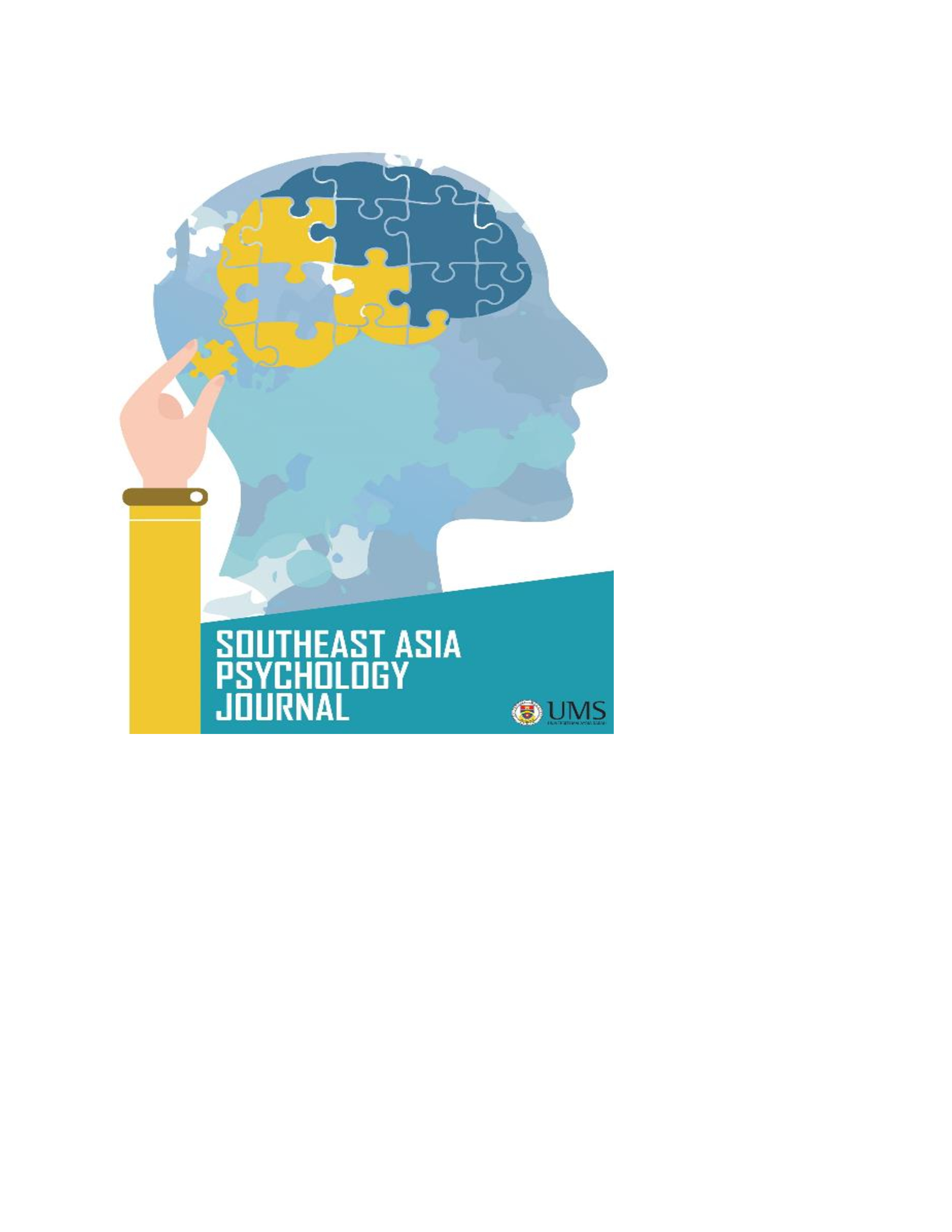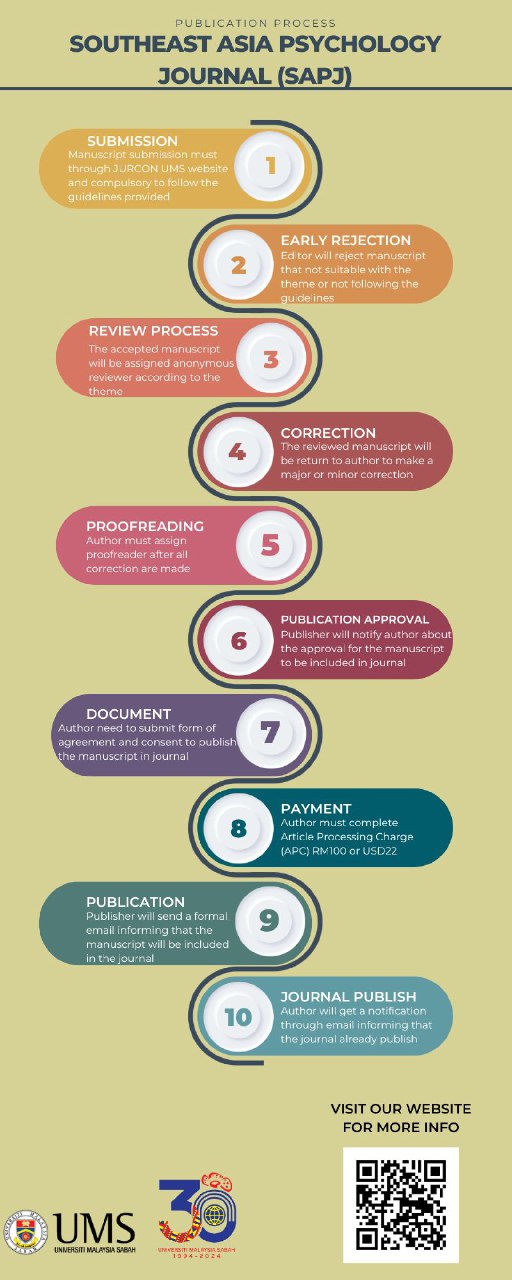PSYCHOMETRIC PROPERTIES OF THE PERSONAL ASSESSMENT OF INTIMACY IN RELATIONSHIPS (PAIR) INVENTORY AMONG NORTH-BORNEO MALAYSIAN COUPLES
DOI:
https://doi.org/10.51200/sapj.v11i2.4908Keywords:
Psychometric Properties, Personal Assessment of Intimacy in Relationships, Malaysian CouplesAbstract
This study aimed to examine the psychometric properties of the Personal Assessment of Intimacy in Relationships (PAIR) Inventory among Malaysian couples. The research specifically focused on evaluating the inventory's reliability, validity, and conducting an item analysis. Data were collected from a convenience sample of 549 respondents. These respondents were either married, engaged, or in committed relationships, living together. The duration of most relationships ranged from one to ten years, and participants were located across Malaysia. The survey was administered through Google Forms and disseminated via WhatsApp using the snowballing method. The study utilized the Personal Assessment of Intimacy in Relationships (PAIR) Inventory, which comprises 36 items divided into six subscales. These subscales measure emotional, social, sexual, intellectual, recreational intimacy, and conventionality. Item analysis revealed issues with some items, especially within the Social Intimacy scale. As for reliability, the entire PAIR instrument displayed good consistency with a Cronbach's Alpha of 0.77. Nevertheless, there were variations in the reliability of subscales. Emotional Intimacy achieved an alpha value of 0.74, and Intellectual Intimacy reached 0.71, meeting the reliability criterion. However, some other subscales did not meet the threshold. Furthermore, problematic items were identified through item analysis. In terms of validity, both convergent and concurrent validity were assessed. All PAIR subscales demonstrated positive and significant intercorrelations, with the exception of the Social Intimacy scale. Concurrent validity was evident through positive associations between PAIR subscales and well-being measures. Once again, the only exception was the Social Intimacy scale. In conclusion, this study offers valuable insights into the psychometric properties of the PAIR Inventory among Malaysian couples. It highlights the need for improvements, especially within the Social Intimacy scale.
References
Abamara, N.C., Abamara, I. C., Udeze, C. N., & Ibekwe, L. (2018). Marital Satisfaction Among Married
People in Awka: A Factorial Study of Intimacy and Libido. International Journal of Health and Social Inquiry, 4(1). 77-100.
Baptist, J., Norton, A. M., Aducci, C. J., Thompson, D. E., & Cook, A. (2012). Relationship Maintenance Behaviors: A Cross-Cultural examination of emerging adults in romantic relationships. Journal of Couple & Relationship Therapy, 11(1), 33–50. https://doi.org/10.1080/15332691.2012.639703
Chua, B. S., Jasmine, A. M., Ferlis, B., Lailawati, M., and Asong, J. (2015). Development and Validation of Employee Trust Scale: Factor Structure, Reliability and Validity. International Scholarly and Scientific Research & Innovation, 9(8). https://doi.org/10.5281/zenodo.1109527
Constant, E., Vallet, F., Nandrino, J.-L., & Christophe, V. (2016). Personal Assessment of Intimacy in Relationships: Validity and Measurement Invariance Across Gender. European Review of Applied Psychology, 66(3), 109-116. https://doi.org/10.1016/j.erap.2016.04.008
Department of Statistics Malaysia. (2022, November 25). Marriage and Divorce Statistics,Malaysia,2022.https://www.dosm.gov.my/v1/index.php?r=column/cthemeByCat&cat= 453&bul_id=dWs0eGorT1RzSzNncFhqQlhIYXpOZz09&menu_id=L0pheU43NWJwRWVSZkl WdzQ4 TlhUUT09
Diener, E., Wirtz, D., Tov, W., Kim-Prieto, C., Choi, D., Oishi, S., & Biswas-Diener, R. (2009). New measures of well-being: Flourishing and positive and negative feelings. Social Indicators Research, 39, 247-266. https://eddiener.com/scales/9
Gharaibeh, B., Ahmed Mohammad Al-Smadi & Boyle, D. (2017). Psychometric properties and characteristics of the Diabetes Self-Management Scale. International Journal of Nursing Sciences,4(3), 252-259. https://doi.org/10.1016/j.ijnss.2017.04.001.
Heather, M. (1996). Intimacy (ED393053). ERIC. https://files.eric.ed.gov/fulltext/ED393053.pdf Hook, M. K., Gerstein, L. H., Detterich, L., & Gridley, B. (2003). How close are we? Measuring intimacy and examining gender differences. Journal of Counseling & Development, 81(4), 462-472.
Krabbe, P. F. M. (2017). The Measurement of Health and Health Status: Concepts, Methods and Applications from a Multidisciplinary Perspective. Elsevier. https://doi.org/10.1016/C2013019200-8
Lafontaine, M., Hum, L., Gabbay, N., & Dandurand, C. (2017). Examination of the Psychometric Properties of the Personal Assessment of Intimacy in Relationships with Individuals in Same-Sex Couple Relationships. Journal of Glbt Family Studies, 14(4), 263–294. https://doi.org/10.1080/1550428x.2017.1326017
Loggins, B. (2022, November 16). What Is Intimacy in a Relationship? Verywell Mind. https://www.verywellmind.com/what-is-intimacy-in-a-relationship-5199766
Mark, T. S., & David, H. O. (1981). Assessing Intimacy: The Pair Inventory. Journal of Marital and Family Therapy. https://depts.washington.edu/uwcssc/sites/default/files//PAIR%20article.pdf
Moore, K. A., McCabe, M. P., & Stockdale, J. E. (1998). Factor Analysis of The Personal Assessment of Intimacy in Relationships Scale (PAIR): Engagement, Communication and Shared Friendships. Sexual And Marital Therapy, 13(4), 361-368. http://dx.doi.org/10.1080/02674659808404254
Nawratek, K., & Mehan, A. (2020). De-colonizing public spaces in Malaysia: dating in Kuala Lumpur. Cultural Geographies, 27(4), 615-629. https://doi.org/10.1177/1474474020909457
Nurul Huda, M. R. (2020). Intimacy Under Surveillance: Illicit Sexuality, Moral Policing, and the State in Contemporary Malaysia. Hawwa, 18(2-3), 325-356. https://doi.org/10.1163/15692086-12341381
Park, Y., Impett, E. A., Spielmann, S. S., Joel, S., & MacDonald, G. (2021). Lack of Intimacy Prospectively Predicts Breakup. Social Psychological and Personality Science, 12(4), 442- 451. https://doi.org/10.1177/1948550620929499
Sumari, M., Baharudin, D. F., Khalid, N. M., Ibrahim, N. H., & Tharbe, I. H. A. (2019). Family Functioning in a Collectivist Culture of Malaysia: A Qualitative study. The Family Journal, 28(4), 396–402. https://doi.org/10.1177/1066480719844334
Sadeghi, K. (2013). Doubts on the validity of correlation as a validation tool in second language testing research: the case of cloze testing. Language Testing in Asia, 3(1). https://doi.org/10.1186/2229-0443-3-15
Schaefer, M. T. & Olson, D. H. (1981). Assessing Intimacy: The Pair Inventory. Journal of Marital and Family Therapy, 7(1), 47-60. https://doi.org/10.1111/j.1752-0606.1981.tb01351.x
Ursachi, G., Horodnic, I. A., Zait, A (2015). How reliable are measurement scales? External factors with indirect influence on reliability estimators. Procedia Economics and Finance 20 (2015), 679 – 686. https://doi.org/10.1016/S2212-5671(15)00123-9
Walker, L. M., Hampton, A., & Robinson, J. W. (2014). Assessment of Relational Intimacy: Factor Analysis of The Personal Assessment of Intimacy in Relationships Questionnaire. Psycho Oncology, 23(3), 346-349. https://doi.org/10.1002/pon.3416







